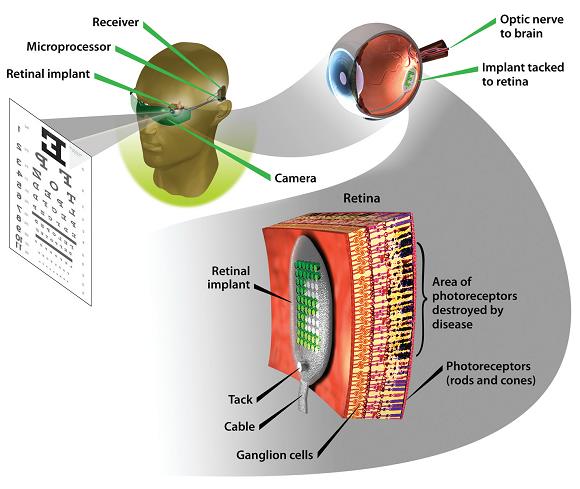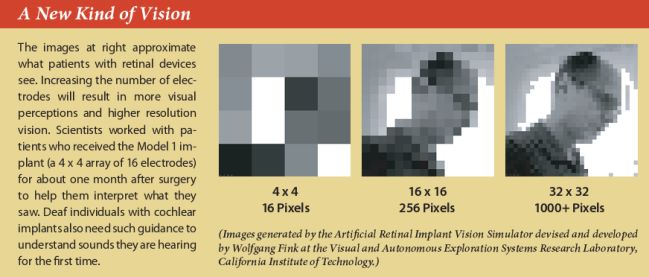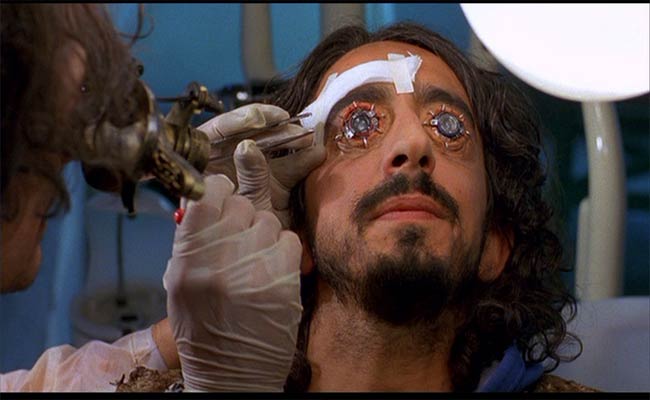February 17, 2007
The Bionic Man Wears Glasses

The BBC News reported that retinal implants have been approved for trials in about 50 to 75 patients. Early results by a team headed up by the Doheny Eye Institute, with funding by the Department of Energy show that those blinded by retinal diseases can get partially restored vision with an implantable microelectronic retinal device. In the picture above,
- The Camera on the glasses views image
- Signals are sent to hand-held device
- Processed information is sent back to glasses and wirelessly transmitted to a receiver under surface of eye
- The receiver sends information to electrodes in retinal implant
- Electrodes stimulate retina to send information to brain

“What we are trying to do is take real-time images from a camera and convert them into tiny electrical pulses that would jump-start the otherwise blind eye and allow patients to see,” said Professor Mark Humayun, from the University of Southern California.
Both diseases cause the retinal cells which process light at the back of the eye to gradually die.
The new devices work by implanting an array of tiny electrodes into the back of the retina. A camera is used to capture pictures, and a processing unit, about the size of a small handheld computer and worn on a belt, converts the visual information into electrical signals. These are then sent back to the glasses and wirelessly on to a receiver just under the surface of the front of the eye, which in turn feeds them to the electrodes at the rear.The whole process happens in real time.
…”It’s amazing, even with 16 pixels, or electrodes, how much our first six subjects have been able to do”…The new implant has a higher resolution than the earlier devices, with 60 electrodes.
Now clearly we’re seeing significant improvements in a relatively rapid timeframe - so much so that one wonders when the contact lens retinal implants will hit the market. After that, color is just around the corner. I can already see the bionic eye folks screaming, “I want HD quality contacts!” Seriously though, this is fascinating stuff, and shows yet another fantastic innovation in overcoming limitations with our bodies.
As these things become commonplace, the notion of a “natural” human may go by the wayside. Currently, prosthetics and implants are meant to overcome real loses so that patients can lead normal lives. It’s not too much of a stretch to see these advances used to further existing human capabilities. Imagine for instance, adding an implant to your eye to allow you to “see” through a mobile robot that you “control” with your mind (we already have direct prosthetics control connected to our nervous systems). In effect this becomes another limb, but is one detached from your body (I’m going to call mine a tachikoma!). You can give it commands, watch its movements, and even ignore it if you like while it goes through predetermined programs.






Comments
February 17, 2007
InnateMalk said:
I heard about this while doing psychology last year, it’s a nice step towards real cyborg upgrades, but untill we get resolutions of around 3488×2616 I can’t see many people rushing out to have their eyes replaced.
http://daily.greencine.com/archives/stand-alone-complex-eye.jpg
Illusive Mind said:
I just saw this on the news.
Pretty amazing, let’s chuck a Canon 5D CMOS sensor on one of these babies. 12 MILLION PIXELS!!!
October 9, 2007
Greg Benton said:
I have optic atrophy.Is there any implants for the optic nerve behind ear.I heard that there was.Please respond while I still have some vision.